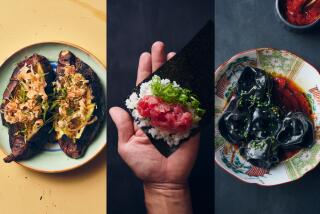Ordering off the menu: Follow the paper trail
Otomisan is a rare discovery: a tiny home-style Japanese restaurant -- in Boyle Heights.
Although the area has not been a center of the Japanese American community since before the forced relocation to internment camps during World War II, Otomisan, which opened in the mid-1970s, has attracted enough customers of whatever ancestry to stay in business for 25 years.
Situated on busy 1st Street in a cluster of business, the restaurant is almost hidden behind security bars that make it seem closed. Only the “Yes, we’re open” signs on both sides of the door give the first-time visitor confidence to enter.
Inside, there are just three booths and a counter with five stools. Floral-printed noren (curtains) screen off the kitchen. Two large lanterns dangle over the counter. Miscellaneous curios, pictures and a calendar in Japanese make up the sparse decorations, and strips of paper naming dishes in Japanese are posted on the walls. An English menu is available, but some of the most interesting dishes are listed on those strips.
One is yamakake, a slightly sweet bowl of cool, slippery grated mountain yam seasoned with tempura sauce and garnished with chunks of raw tuna. Yamakake is not to everyone’s taste -- even some Japanese don’t like it, the cook told me -- and when I order it, he steps out of the kitchen to gauge my reaction. In fact, it is delicious: fresh, light and delicately flavored. There is nothing odd about it.
Now that I have proved myself, he suggests I try the dish on the paper strip next to yamakake. It turns out to be tuna sashimi, almost hidden under a snowy drift of grated daikon with a spoonful of wasabi clinging to one side of the graceful blue-and-white bowl. Again, it was delicious, and the unusual presentation added to its appeal.
A Japanese friend had recommended unagi donburi, another dish from the paper strips. This is comfort food: freshwater eel cooked golden brown and sweetened with a sugary glaze. Arranged on top of a bowl of sticky rice, the slices of eel at Otomisan are so soft they virtually melt into the rice as you eat.
In some cases, an English word accompanies the Japanese script. “Squid” means plain fried squid -- no crunchy coating -- sliced into rings and accompanied by lemon wedges and lettuce with a sweet white dressing. “Saba” is mackerel served the same way. It’s a meaty, somewhat oily fish with a sturdy texture and a rich, pleasing taste.
The English menu offers sushi, rice bowls, udon noodles, combinations such as teriyaki and tempura and a few a la carte dishes, including sukiyaki, fried shellfish and a couple of tofu items. There are also six Chinese dishes. The sweet and sour pork -- made with carrots, onion, bell pepper, zucchini (no pineapple!) -- is pretty good, subtly colored with tomato and not too sweet.
The sushi is rudimentary but good enough for a small restaurant that doesn’t aim to be a sushi bar. A mixed plate includes rolled sushi filled with avocado and imitation crab and nigiri sushi topped with tuna, salmon marinated in vinegar with salt and shrimp, seven pieces in all.
Sukiyaki, served in a black iron bowl, is uncomplicated, the way a Japanese housewife might prepare it quickly for a family meal. Curly thin slices of sukiyaki beef join onion, nappa cabbage, shirataki noodles and tofu cubes in a light, sweet broth.
Chicken for teriyaki is cut into small pieces, and the teriyaki sauce is lighter in color and sweeter than usual. There’s beef teriyaki too.
Although the tempura had been recommended by a regular customer, it didn’t show well, at least when I ordered it. The breading on the shrimp and vegetables was undercooked and the oil tasted stale.
All dishes come with sweet and sour cucumber slices and bean sprouts seasoned with a dash of sesame oil, served in little dishes from the assortment stacked on shelves behind the counter. A meal brings a charming collection of these Japanese dishes, each a different shape and pattern, to the table.
The table condiments include soy sauce for the tuna, ground chiles, Thai hot sauce and Mexican chile con limon, the only reflection of the neighborhood’s demographics that I’ve seen in this restaurant.
Green tea, in slim Japanese mugs, is replenished as needed.
Sticky short-grained rice also accompanies orders, but there is usually no dessert, although once I received a cellophane-wrapped fortune cookie -- perhaps an escapee from the Chinese portion of the menu.
*
Otomisan
Location: 2506 1/2 E. 1st St., Los Angeles, (323) 268-2421
Price: Main dishes, $4.50 to $8.50; sushi, $2 to $6.50; combination plates, $5.50 and $6.50
Best dishes: Yamakake, tuna sashimi with daikon, unagi donburi, sukiyaki, chicken teriyaki
Details: Open 11 a.m. to 8 p.m. daily. No alcohol. Street parking. Cash only.










